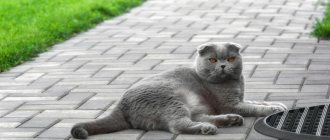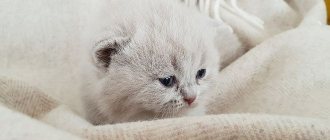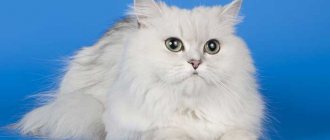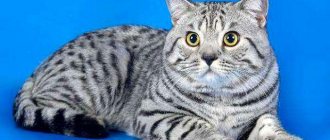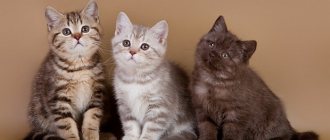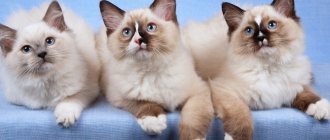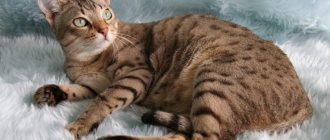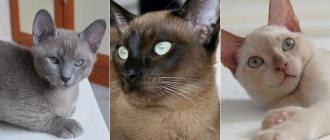British cats are one of the most sought after pets. Not only shorthaired cats have gained worldwide popularity, but also their furry relatives - British Longhairs, or Highlanders. A cute face, thick, long hair with a fluffy tail and a golden cat character are three reasons to fall in love with this breed.
What does a British Longhair cat look like?
In appearance, fluffy Britons are similar to their short-haired counterparts. Mature cats have a powerful and large body with a wide chest and straight back, short neck. The animals have massive shoulders and hips. A distinctive feature of the breed is the unusual structure of the muzzle, namely thick cheeks and large bright eyes. Females weigh 3.5-5.5 kg, males reach 6-7 kg.
Muzzle
Even in the photo you can see that the head of a British longhair cat is round and massive, the muzzle is slightly smoothed, but not flattened, the chin is strong, perpendicular to the line of the nose. The ears are widely spaced, small, and round in shape. The nose is straight, short, wide and slightly raised upward.
The calling card of the long-haired British is fluffy, rounded cheeks, as well as skin folds on the neck and belly. The eyes are expressive, large and round, their color matches the color of the animal: it can be emerald, blue, yellow, dark orange or copper. The cat's distinctive whisker pads, well-furred tail and large chin give the cat a special charm.
Body type
Highlanders (the second name for the long-haired British) have a squat and muscular body, a massive, wide back and shoulders, a short and strong neck, and rounded and powerful legs. The tail is 2/3 of the body length, thick at the base and gradually tapers to a rounded tip. Its fluffiness makes it especially attractive.
Coat and color
In purebred animals, the coat is thick, erect and semi-long: shorter on the shoulders and lengthening towards the back. It has a soft texture, does not fit tightly to the body and is a natural protective covering.
The varieties of British Longhair cats in terms of coat color are numerous and varied. The classic colors of the breed are lilac and blue.
The colors of British longhair cats are:
- tortoiseshell
– is an alternation of spots of several shades throughout the body, for example, orange and black or yellow;
- smoky
– the color resembles smoke or chinchilla: the undercoat is snow-white, and the dark color is only at the tip of the hair, while the back, limbs, and head have a more saturated tone;
- tabby
– animals can be striped or spotted and have a ticked pattern, for example, the letter “m” on the forehead; the contrast of shades in the color of the coat is bright;
- bicolor
– when the main tortoiseshell tone, occupying more than ½ of the body, is combined with white, and there is a bright spot on the fluffy face;
- color point
– the animal’s fur is snow-white, and its ears, tail and paws are dark.
There are more than 100 coat colors of the British Longhair. The rare and original color makes the pet more interesting, but in no way distinguishes it as a separate subspecies of the cat genus.
Description of the breed
The English ancestor gave the “British” a proportionate, strong body with developed muscles, and the Scottish ancestor gave him an amazing variety of colors.
Although there are no breed standards, breeders identify a British Fold cat by the following external characteristics:
- the head is round, cheeky and high cheekbones, the chin is pronounced;
- the nose is short, smooth, slightly flattened;
- the neck is thick, inconspicuous;
- the eyes are large, round, the color of the iris is determined by the color;
- ears are medium in size, straight or curved, the base is wide, the tip is slightly rounded;
- the chest is voluminous and wide;
- the limbs are strong and short, the paws are rounded, the toes are neatly positioned;
- the tail is short, mobile, the tip is slightly narrowed, rounded;
- The coat is dense and pleasant to the touch, the undercoat is voluminous, the hairs are longer and shorter.
ATTENTION! British kittens are not born with droopy ears. Folding ears begin to appear on the 20th day from birth.
Personality of the British Longhair cat
When you take home a fluffy kitten, you can count on it to grow into a loyal, obedient and affectionate friend. Long-haired British cats play with their owners with pleasure, quickly get used to the tray, and do not require special care or increased care.
Over the years, pets become leisurely and calm, which is manifested in a decrease in their activity and a desire to rest most of the time. Unlike females, British cats remain active much longer, which is due to earlier sexual maturity.
The character of the British Longhair cat is good-natured and accommodating. These are very inquisitive and sedate animals, not devoid of self-respect. They do not show aggression or any intrusiveness, get along well with children, but do not tolerate attention to themselves in the form of constant stroking or being carried in hands.
Cats are very reserved and tolerate loneliness well - long absence of their owners is not a serious problem for them. A purebred cat is well-mannered and smart, she easily adapts to new conditions and feels equally at home in a house and a city apartment.
Raising a British Longhair cat
You have become the owner of a gorgeous fluffy dog. What rules of behavior should be instilled in a four-legged friend in the early years of life in order to avoid problems in the future? Many breeders agree that an adult cat must fulfill the following requirements from the owner:
- keep the house clean, only go to the litter box;
- sleep in a designated place;
- respond to your nickname, understand and carry out “command” words;
- do not damage carpets and furniture;
- do not climb on curtains and curtains;
- do not jump on the kitchen and dining table;
- do not steal food from plates;
- do not spoil ornamental plants;
- don't be aggressive.
Raising a British Longhair cat needs to start from an early age so that the animal does not develop stupid habits that will be very difficult to get rid of. When a pet arrives, it is important to immediately let it know who is boss. If the cat can dominate, then this will develop into many problems in the future.
What classical methods should be used in education? Looking at the kitten, repeat the commands in a firm voice and at the same time show what is required of him. For example, when saying “down”, remove the naughty person from the table, window sill, chair where he jumped. Say “no” whenever the animal does something undesirable, such as damaging the carpet with its claws. The business tone of the commands is also important: the kitten must understand its breeder the first time, without numerous repetitions.
If a cat ignores its owner, its behavior should be corrected immediately. Punishment should occur immediately after the offense. You can easily slap the animal on the back with a rolled-up newspaper, this is especially effective when the cat bites its hands or screams loudly.
But due to the specific character of the British Longhair, such methods of punishment should be used in exceptional cases, since the animal can become aggressive, start scratching and snapping unreasonably - or simply avoid the company of its owner.
An effective way is to spray the kitten with water from a spray bottle when, for example, it bites flowers or climbs on a table. Usually a few times are enough for the animal to realize that such behavior is unacceptable in the house. There is no point in attracting attention to yourself - punishment should not be associated with the breeder.
An equally harmful tendency is cat begging and theft. To overcome the problem at an early age, the animal should be fed at the same time, in the designated place and from the same container. Once accustomed to a routine, the kitten will ask for food at certain times and only if it is hungry.
Never throw food at your cat after doing something wrong, otherwise she will take it as encouragement and continue to behave that way. And, of course, give your pet more attention, love, care and warmth - then peace and tranquility in the family are guaranteed.
Breeding
Breeding should be carried out exclusively with the onset of puberty of animals. Another important feature you need to know about is your pet’s blood type. If the female has blood type B and the male has type A, then during the crossing there is an extremely high probability that the kittens will die soon after birth. This happens because antibodies to a different blood type are triggered.
It is possible to determine whether a cat is pregnant after copulation or not after a couple of weeks.
British Longhair cat health
The British have naturally good health and good stamina. Oncological diseases and other serious illnesses are extremely rare in them.
Possible diseases
A healthy cat means happiness in the family. Longhaired British cats do not bother their caring owners with their illness, this is due to their innate strong immunity. But animals still have some health problems:
- British fluffy cats have a lot of fur - the reason lies in a lack of vitamins, poor diet or pathology of the gastrointestinal tract;
- cats have an excellent appetite and are obese - the solution to the problem will be control of the amount of food by the owner and regular active games;
- hypertrophic cardiomyopathy – regular ultrasound examination of the heart will identify the disease at an early stage and prevent its further development;
- polycystic kidney disease - the disease is inherited, there are no preventive methods.
It is important to give your furry pet all vaccinations in a timely manner, which will protect against most infectious diseases, for example, rabies, panleukopenia, rhinotracheitis, etc. Regularly carry out anthelmintic prophylaxis, and then the health of the British longhair cat throughout its life will not cause concern.
Reproductive health
The first heat of a British Longhair cat can begin at six months - or at one year. This is an individual question. Similarly with the frequency of “walking” - some cats “flow” every 2 weeks, others 3 times a year. In this matter, the hormonal background and heredity of the animal are important.
Usually, after the first mating, 2-4 kittens are born, then up to 6. Sometimes 8-9 fluffy balls are born at once.
If a cat is needed for admiration and communication, it is worth taking care of castration of the male or sterilization of the female at an early age. The ideal time for surgery is 12 months. Until this time, surgical intervention is prohibited, since the reproductive organs are underdeveloped.
Timely castration and sterilization will not affect the health of your long-haired pet: the operation is performed in a specialized clinic by a qualified surgeon. Complications after the intervention are very rare.
Features of feeding and diet
The general health and appearance of the British Longhair directly depends on a balanced and proper diet.
Your daily diet should include:
- raw and boiled chicken or rabbit meat;
- beef and offal;
- boiled liver;
- sea fish without bones;
- cereal porridges;
- quail and chicken egg white;
- boiled and raw root vegetables, vegetables;
- low-fat fermented milk products without flavoring fillers and chemical dyes;
- special means for removing hairballs from the stomach.
You should not add salt or spices to prepared dishes. It is better to give preference to natural composition. Porridge should be mixed with small pieces of boiled meat or fish.
You can add vegetable oil to boiled vegetables. It is better to avoid butter due to its high fat content. It is important to provide your cat with fresh and clean drinking water.
The following should be excluded from the animal’s daily diet:
- fat meat;
- river fish;
- pickles, smoked meats and sausages;
- flour products;
- potatoes, eggplants;
- raw liver;
- desserts, ice cream and sweets.
The British Longhair can be fed special food with a balanced composition and useful additives. Their range is quite wide; dry and wet food are suitable for everyday feeding.
Care and maintenance
British Longhairs give their breeders a lot of warmth and joy, but they also require similar treatment for themselves. Dense and very thick wool causes a lot of trouble. It does not tangle or form tangles, but requires regular brushing with a soft brush.
The procedure should be carried out once every 7 days; in the spring-autumn period, when molting, combing is performed more often. This allows you to keep clothes, furniture and carpets in good condition. During the molting period, the animal licks itself profusely, which causes fur to accumulate in the stomach. To prevent obstruction, you need to give your cat grass or a special paste.
The long-haired British cat does not need frequent washing, since the hair has a natural fatty coating that serves as a barrier to the penetration and proliferation of pathogenic bacteria. The ears and eyes are cleaned with a cotton swab dipped in chilled black tea or lotion. The procedure is carried out several times a week, the claws are trimmed with regular nail clippers once a month.
Unlike many decorative breeds, the British love walks in the fresh air. This is facilitated by their excellent health and immunity. It is better to walk the animal on a harness to avoid being attacked by stray dogs or being run over by a car.
Due to their tendency to obesity (especially after castration), cats need a lot of physical activity. Together with compliance with feeding standards, this gives a positive result.
In general, caring for and maintaining a British longhair cat is not difficult. It is enough to carry out the necessary hygiene procedures in a timely manner and observe the dosage of food.
Tips for choosing a kitten
The breed of longhaired British cat is very popular in Russia, and buying a kitten does not cause any difficulties. But you can always find an unscrupulous seller offering British longhair kittens with an unclear pedigree and many hereditary diseases. A worthy pet can only be found in a specialized nursery.
It is better to take a kitten from a cat at 2 or 3 months, when the immune system is stronger and the mother has acquired the skills for independent living. At the age of 2.5 months, kittens receive their first rabies vaccination, which must be recorded in the veterinary passport.
When choosing a long-haired British dog, watch its behavior for a while - the animal should be playful and active. Don't forget to inspect the fur: in a healthy kitten it is shiny, soft and smooth. The eyes are clean, without inflammation, the tummy is soft, covered with silky hair.
It is recommended to familiarize yourself with the pedigree of the parents and the documents provided by the breeder. If everything is normal, feel free to buy the baby.
Nutrition
The British Longhair breed does not have any special requirements. The main thing is to choose the right diet and stick to it. There are special ready-made foods for Highlanders, developed taking into account the characteristics of the breed. Choose only high-quality food that will contain all the necessary vitamins and minerals.
If owners want to feed their pet natural food, then the appropriate requirements must be followed. Remember not to feed homemade food from the table. Milk, salty and smoked foods only disrupt the body’s metabolism and do not provide any benefit to the pet’s health.
How much does a British Longhair cat cost?
The price of a British longhair cat is quite high: for example, a show-class kitten can be bought for 700-900 US dollars. This breed is popular among collectors; animals with purple coat color are considered especially valuable. The breed class has some disadvantages, but its price is lower than the elite show class and ranges from 400-700 US dollars.
Pet class is much cheaper. But when purchasing, you should clarify why the animal was assigned to him. Is it due to insufficiently thick hair or incorrectly shaped ears? Then you can buy a small pet.
If it is an incorrect bite of the teeth, a crooked tail or paws, it is better to refuse the purchase, despite the tempting price, which can drop to 100-200 dollars.
Origin story
The breed was developed in England in the 20th century by crossing a British shorthair and a Persian cat. The researchers were faced with the task of creating an impeccable appearance. The emphasis was on Persian cats, since at that time they were considered a perfect breed.
Shorthair British cat
Persian cat
As a result, the long-haired cat was bred, but the experiment to create the ideal species failed. This is due to the fact that the breed has an asymmetrical skull and malocclusion.
Having suffered a fiasco, a ban was given on further crossing of these two breeds. However, fans of this species continued to use the British Longhairs in breeding work thanks to the remaining successful litters.
